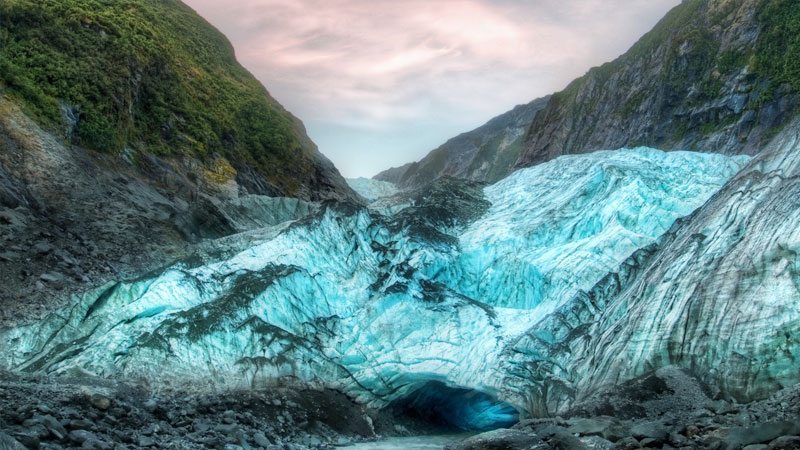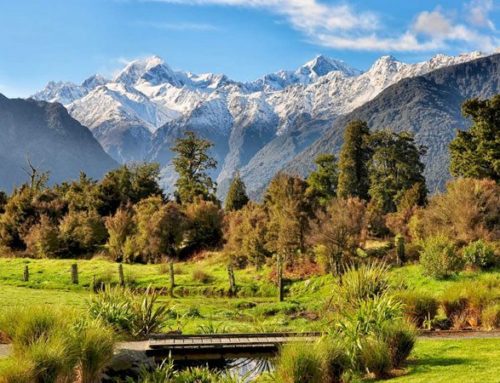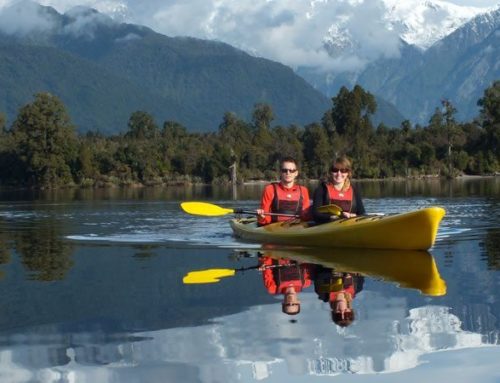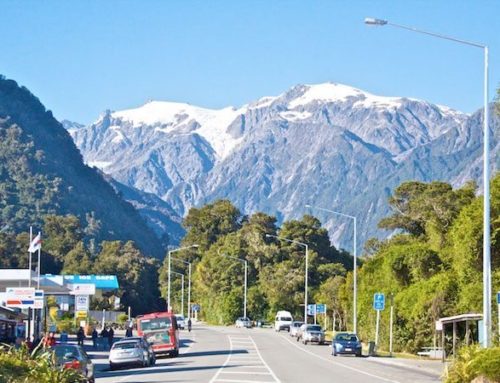The Franz Josef and Fox Glaciers of New Zealand’s Westland National Park are remembered by visitors for the extraordinary sights of glacier ice within the forest zone. From freezing conditions near the mountain crests the glaciers slowly grind their way down-valley into warmer temperatures far below the upper limit of forest. It may seem a contradiction that such glaciers occur in a temperate climate, and that ice and forest are juxtaposed, but there are simple reasons.
What is a Glacier?
A glacier is simply a large body of ice, formed from the snow left over at the end of summer, which is moving slowly downhill. Glaciers occur at high elevations, where winter snowfalls exceed the snow lost from summer melting. Across the accumulation basin (neve) of a glacier, delicate snow flakes partially melt to form whitish granular snow (firn). Over several years, as water seeps in and air is expelled under the accumulating weight of snow, the granules merge to form bluish glacial ice. Under the pull of gravity the ice mass actually flows as though it were a stiff liquid, slowly oozing its way down-valley where it melts away in warmer temperatures.
Why are there Glaciers on a South Pacific Island?
Above the Franz Josef and Fox glaciers stands a chain of spectacular peaks over 3000m high including New Zealand’s highest peak, Mt Cook (3754m 12,316ft). This region, the highest part of the Southern Alps, lies in the path of the westerly airstream which sweeps in continually from the Tasman Sea, As moisture laden winds and frequent storm fronts ascend the mountains, the air cools rapidly causing heavy rain and snowfalls. Annual precipitation at the coast is a dramatic 3.2 metres (125in) but this rises to an amazing 15 metres (nearly 50ft) on the alpine summits. Huge volumes of snow are dumped on the upper slopes of the mountains giving rise to the 140 glaciers which blanket over 200 square kilometres of Westland National Park. The Franz Josef and Fox glaciers are by far the largest of these, containing two thirds of the volume of glacial ice in the park.
Why is there ice in a temperate Rain Forest?
Of the many glaciers along the Main Divide, only the Franz Josef and Fox glaciers penetrate the lower forest zones. This phenomenon is caused by their unique topographic setting, where an exceptionally broad, high block of land at the heads of the glaciers feeds huge amounts of snow and ice into two narrow valleys. The balance of a glacier requires that melting of the tongue equals accumulation in the neve. The narrow tongue of the Franz Josef and Fox glaciers must therefore extend a great distance down-valley so that the zone of melting is large enough to balance the massive snowfall in the catchment area above.
The movement of a Glacier
On the upper mountain slopes at back of the neve, snow and ice pull away from the headwalls along a single crevasse called a bergschrund and then begin to flow slowly downhill. Ice moves by sliding over the underlying rock on a film of water, and by plastic flow within the glacier itself. The deeper the ice the more plastic its behaviour, while the top layer of about 20m thickness rides along as a brittle crust, splitting and cracking into deep crevasses where the glacier flows over humps and hollows and drags against the valley sides. Where steps occur in the bedrock, intense crevassing may form towering blocks of ice (seracs) which may topple into a chaotic jumble (icefall).
With the continual addition of snow to the neve, snow and ice move downward into the glacier, everything on the surface becoming buried deep within the ice. Further down the glacier at the trunk (just below the neve) the flow of ice attains its maximum speed. In the icefalls of the Franz Josef and Fox glaciers rates of up to 4m per day have been recorded, which are very rapid by world standards. For example, in 1943 an aircraft crashed on the Franz Josef Glacier about 4km up from the terminus. Six years later parts of the wreckage appeared at the glacier front.
Lower down the trunk the rate of flow slows as more and more ice melts in the warmer conditions. Here ice flows becomes directed towards the surface to replace ice melted from above. This flow brings rock debris from within the glacier to the surface, where it accumulates as moraine. General movement is in the direction of the banding within the ice. Near the Termius nearly all the ice has been lost, and most of debris from inside the ice now lies on the surface. Though the glacier front may be stationary, the ice near the Main Divide carrying greywacke rock from this area into the schist terrain at the glacier terminus.






Leave A Comment